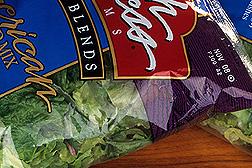This page has been archived and is being provided for reference purposes only. The page is no longer being updated, and therefore, links on the page may be invalid.
Market Lighting Affects Nutrients
By Rosalie Marion BlissMay 3, 2011
Many people reach toward the back of the fresh-produce shelf to find the freshest salad greens with the latest expiration dates. But a study led by U.S. Department of Agriculture (USDA) scientists may prompt consumers to instead look for packages that receive the greatest exposure to light--usually those found closest to the front.
The study was led by postharvest plant physiologist Gene Lester while at the Agricultural Research Service (ARS) Crop Quality and Fruit Insects Research Unit in Weslaco, Texas. ARS is USDA's chief intramural scientific research agency.
Lester and colleagues Donald Makus and Mark Hodges found that spinach leaves exposed to continuous light during storage were, overall, more nutritionally dense than leaves exposed to continuous dark. Lester now works at the ARS Food Quality Laboratory in Beltsville, Md.
For the study, the researchers exposed spinach leaves to light similar to the 24-hour artificial fluorescent light received by spinach in packages located at the front of the display case. A second group was enclosed in two-layer-thick, brown-grocery-bag paper to represent the "dark treatment."
Both experimental groups were housed in market-type, light-transmissible polymer tubs with snap-tight lids and were kept in walk-in storage chambers at 4 degrees Celsius, the same temperature at which markets currently display packaged spinach. The light reaction of photosynthesis is not temperature-dependent and can occur at 4 degrees C in the right type of light.
The researchers found that the continuous light affected the leaves' photosynthetic system-resulting in a significant increase in levels of carotenoids and vitamins C, E, K, and B9, or folate.
While the simulated retail light conditions actually helped the stored leaves gain in content of several human-healthy vitamins, some wilting occurred after three days of storage in flat-leaf spinach, but not crinkled-leaf types.
Results from this work were published in the Journal of Agricultural and Food Chemistry.
Read more about this research in the May/June 2011 issue of Agricultural Research magazine.

